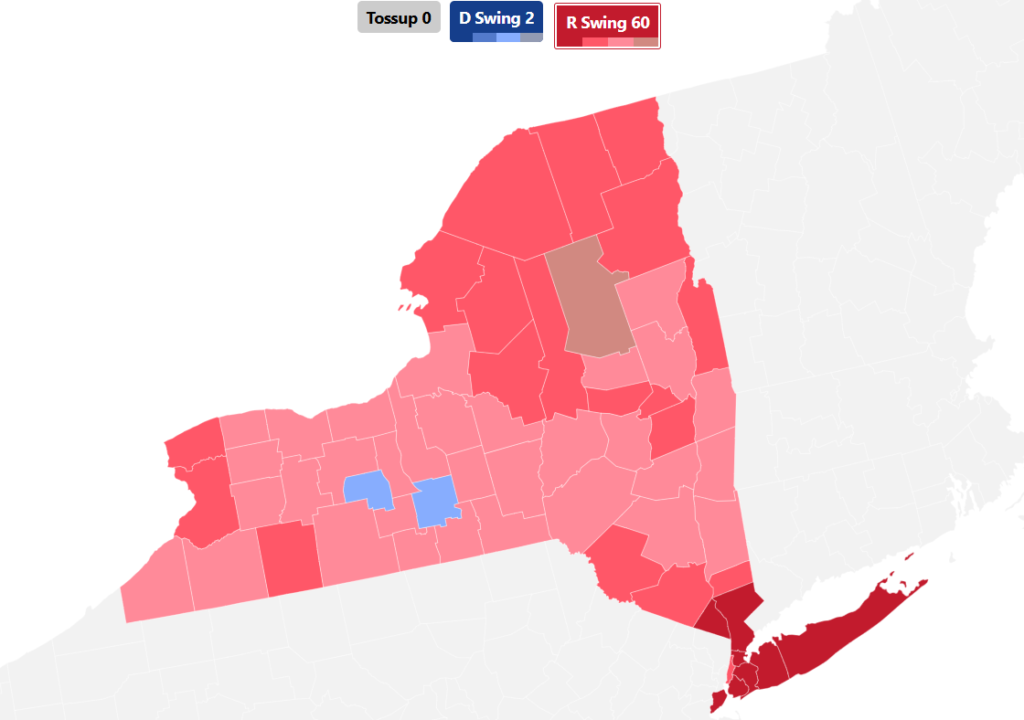With all votes finalized, we can continue our full autopsy and analysis of the 2024 elections. We plan to continue our state-by-state breakdowns in this column, picking up from New England last week, into the Empire State this week.
Presidential Politics in New York
New York State has not backed a Republican presidential nominee since Ronald Reagan (R-CA) in 1984. Although it was a close race in 1988, the state has not seen a single-digit result, nor has it seen as close a result as was produced this year. The 1992 election marked the turning point for New York to become a reliably and solidly blue state, after spending a decent amount of the Twentieth Century as a red-leaning battleground.
With all votes reporting, Vice President Kamala Harris (D-CA has won New York by just under thirteen points, about half the margin by which Joe Biden (D-DE) won the state in 2020. The closest result since 1984 was 2004, where George W. Bush (R-TX) capitalized on his handling of the September 11 attacks. The swing wasn’t dramatic, but Bush captured 40% of the vote, dragging Senator John Kerry (D-MA) under 60%. Bush still failed to capture key counties, such as Suffolk.
The Obama years saw the state shift even more dramatically to the left, as solidly-blue New York City backed him, as well as a cadre of Upstate counties that house a classically Democratic, working-class population.
Although Donald Trump (R-FL) flipped many counties in 2016, including Suffolk, he still failed to capture 40% of the vote. Biden flipped back four counties that Trump had won in 2016, still maintaining 60% of the vote statewide. Interestingly, despite Biden holding the line in New York and swinging almost every county towards the left, Trump swung seven counties to the right, including the four Democratic Boroughs of New York City.
In 2024, polling had indicated a tighter-than-expected race against Trump and Biden. The ceiling hadn’t improved much for Harris, with many reputable pollsters, such as the Siena College and Emerson College, tracking her at low-double-digit margins, more or less exactly where the final result ended up. However, Siena and other pollsters tracked Harris leading the state by closer to twenty points in the home stretch of the election.
This election marks the first time that New York voted more Republican than Washington state (1956), Connecticut (1960), and Delaware (1980).

Long Island
We’ll analyze the results within Suffolk and Nassau counties first. We plan to do a further in-depth analysis on how Suffolk County’s towns, villages, and hamlets voted in a separate issue.
For context, no Republican had won Suffolk County since George H.W. Bush (R-TX) in 1992, despite losing the state and the election to Bill Clinton (D-AR). While Suffolk would consistently back Democrats for twenty years, their margins were substantial. George W. Bush (R-TX) lost Suffolk by almost ten points in 2000, but just narrowly lost in 2004. While somewhat close, Barack Obama (D-IL) would win fairly comfortably here.
Trump flipped Suffolk in 2016, winning it by seven points. In 2020, he would retain the nation’s largest suburban county, but only by 200 votes out of over 750,000 ballots cast.
This year, however, Trump’s ten-point margin is the largest since Gerald Ford (R-MI) won Suffolk by about nine points in 1976. His margin is just behind that of Herbert Hoover’s (R-IA) thirteen-point win in Suffolk in 1932.
Although consistently Democratic from 1996 until 2016, and with consolidation of local power in the Democrats’ corner from 2000 until 2021, Suffolk seemed like a much bluer county than its ancestry would imply. Going back to the birth of the Republican Party in 1856, Suffolk County has only backed nine Democratic presidential nominees. Trump’s blowout win here, along with State-level Republicans wins or close margins in blue districts, is interpreted by many as evidence that Suffolk is now a “crimson-red” county yet again.
To add context, Trump flipped two townships he had not carried here before: Huntington and Babylon. Babylon is especially shocking, as he won the formerly deep-blue township by over five points. He also won the Fourth Assembly District – including Port Jefferson, Poquott, Old Field, Stony Brook, and Setauket – by 700 votes, a remarkable feat for a top-of-the-ticket Republican in formerly deep-blue territory.
With the 2024 results in, Suffolk County delivered 417,549 votes to Trump, translating to a 54.74% margin. Harris took 341,812 votes for a 44.81% loss. Third-party candidates received a collective 3,488 votes, 0.46% of the total countywide vote.
This makes Suffolk County the largest county in the nation to vote for Donald Trump in all three of his elections. From barely winning Suffolk four years ago to taking it by storm this year, it translates to an eleven-point swing from last year.
Meanwhile, in next-door Nassau County, Trump’s four-point margin is a startling improvement from his ten-point loss in 2020. Trump is also the first Republican to win Nassau since George H. W. Bush in 1988. Like Suffolk, Nassau has a deep-red ancestry, backing Democrats just ten times going back to 1900, when Nassau and Queens split to become separate constituencies.
Trump took Nassau with 51.44% of the vote, with 367,442 raw votes. His margin is the best for a Republican since Richard Nixon (R-CA) in 1968, and the flip accounts for a fourteen-point rightward swing.
New York City
Some of the sharpest Republican swings in the country came from New York City, which has collectively shifted almost thirty points towards the right in the last three elections. The last time a Republican has won all five Boroughs of NYC was in 1924, when Calvin Coolidge (R-MA) also swept every county in the state, the last time a Republican has done so.
The last time any Republican won any Borough in New York, besides Staten Island, was Richard Nixon in 1972, when he won Queens.
Trump’s largest swing in the state, and one of the largest nationwide, was the Bronx, where it shifted twenty-two points to the right compared to 2020. Harris still won by forty-five points – a landslide – but Trump’s ability to close the gap and garner almost 30% of the vote is one of the major reasons that New York was so close this year, and why Harris lost the nationwide popular vote. His spring rally at Crotona Park turned heads, but his time spent stumping in the deep-blue borough has clearly paid off.
Just behind the Bronx is Queens, coming in at a twenty-one point rightward shift. Harris took Queens by twenty-five points, but Trump garnered almost 40% of the vote.
In Brooklyn, Trump produced an eleven-point rightward swing, taking just under 30% of the vote.
Manhattan swung about ten points towards the right as well, giving Trump just 18% of the vote. Despite the lopsided Harris win in the Big Apple, it’s a stark contrast from 2020, when Trump barely got 12% of the vote.
Even Staten Island, the island of red in a sea of blue in NYC, swung hard to Trump. It trended towards Biden four years ago, but Trump has shifted it fifteen points to the right, winning by a blowout margin of 65%.
The electoral results in New York City this year are likely to be studied for decades, as Trump defied the polls and some forms of conventional political wisdom to radically transform his base. The younger, diverse, and working-class population from New York City speaks to a new coalition that is being observed in other large swings across the country, and, if it should remain, the GOP has a remarkably higher floor in New York going forward. Harris’ failure to win the state by more than one million votes is also a testament to the hemorrhaging Democrats experienced. While Trump gained just 95,000 voters in the city, Democrats lost about a half a million.
Hudson Valley
The Hudson Valley, despite being in ostensibly more Republican territory, didn’t swing quite as hard to the right as some might have anticipated, and some counties remained in the Democratic column, despite Trump flipping other key suburban counties across the state.
Trump’s biggest swing outside Long Island and NYC is Rockland County, a county he lost four years ago, but won by four points this year. It translated to a fourteen-point swing in a county, likely aided by the Jewish population here. Rockland has the largest Jewish population percentage of any county in the nation – 31.4%, or 90,000 residents.
Despite losing Westchester County by almost twenty points, Trump still shifted it ten points in his party’s favor. Other blue Hudson Valley counties include Ulster – which backed Harris handily, but swung narrowly towards Trump – Dutchess, and Rensselaer counties. Rensselaer was one of the three counties he won in 2016, but lost this year. The others are Saratoga (Ballston Spa) – also the fastest-growing Upstate county – and Broome County (Ithaca).
Capital Region, North Country, and Mohawk Valley
In the Capital Region, Trump was able to swing Albany and Schenectady counties about five points each, while still losing them handily. Saratoga County is one that Trump had won in 2016, but lost to Harris this year, albeit very narrowly.
Moving north, Trump carried every county in the North Country, which extends past Albany and out towards Lake Ontario. Trump flipped Clinton County in the far northeastern corner of the state, becoming the first Republican to win it since 1992. He also flipped bordering Essex County, an ancestrally Republican county that backed Obama twice, flipped to Trump, then flipped to Biden.
In the Mohawk Valley, Trump held the line, swinging each of these already-Republican counties towards the right even more, even winning Oneida County, home to Utica.
Western New York
While New York’s electoral clout is usually confined to NYC and Long Island, Upstate cities that back Democrats have proven to be a stumbling block for Republicans running statewide. Even as Lee Zeldin (R-Shirley) took the necessary 30% of the NYC vote to compete statewide, these Upstate cities didn’t come out for him. They did the same for Trump this year.
In Onondaga County (Syracuse), Harris won by twenty points, even as Trump swung the county three points to the right.
In Monroe County (Rochester), Harris mirrored her margin in Syracuse, despite a rightward shift of two points.
Finally, in Erie County (Buffalo), the least Democratic-leaning of the trio, Harris won by just ten points, but Trump swung it five points to the right.
Harris has only outperformed Biden in just two counties: Yates (Penn Yan) and Tompkins (Binghamton). Trump took Yates County by sixteen points, but Harris improved her score by 2.5% compared to Biden four years prior. Harris won Tompkins County in a 75%-25% blowout, a typical Democratic margin in this deep-blue college town-county, but she gained an extra point of support that Biden did not have.




